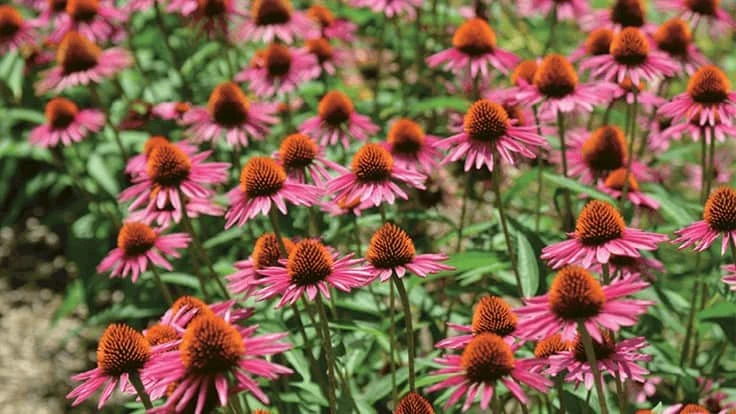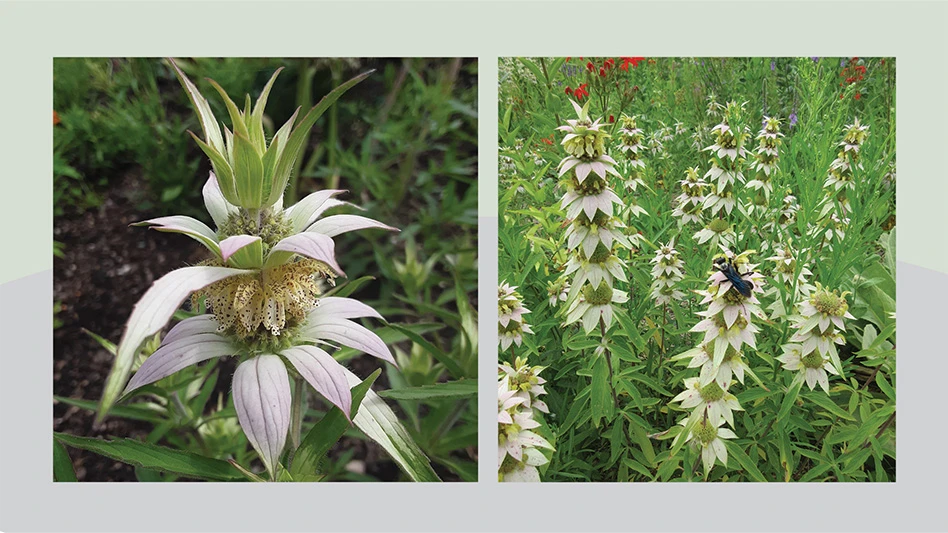
Echinacea, commonly known as coneflowers, are among the most iconic and recognizable native plants in North America. The earliest documented horticultural use of Echinacea can be traced to the late 17th century when Echinacea purpurea seeds were sent to England by the Virginia clergyman and naturalist John Banister. Medicinal use dates back even further as Native Americans used Echinacea to treat a variety of ailments, a tradition that has carried into modern times.
The nine species of Echinacea are North American natives and predominantly occur in the central and eastern United States. The majority of wild coneflowers display pink, purple, and rarely white flowers from late spring to summer. Only one species, Echinacea paradoxa, breaks this color trend and produces canary yellow blooms in June.
What follows are the top-rated coneflowers for the mid-Atlantic from a horticultural and ecological perspective based on the Mt. Cuba Centers’ trials:

Echinacea purpurea ‘Pica Bella’
Echinacea purpurea ‘Pica Bella’ ranked among the top performing coneflowers in our first trial in 2009 and is again one of the most outstanding cultivars we evaluated. ‘Pica Bella’ is a compact and floriferous form of the species that originated as a seedling of Echinacea purpurea ‘Abenstem’. While many Echinacea cultivars in the market today showcase vibrant blooms that can look out of place in a naturalistic setting, the floral display of ‘Pica Bella’ resembles that of Echinacea purpurea, allowing for its effortless incorporation into a broad range of garden designs. This cultivar was also a favorite among pollinators that flocked to its prominent orange cones.

Echinacea ‘Sensation Pink’
A product of the breeding efforts of Marco van Noort in the Netherlands, Echinacea ‘Sensation Pink’ produced one of the most vibrant displays in our trial. Intense, neon-pink flowers are held on dark stems that further accentuate their otherworldly floral color. In contrast to the exuberant blooms, ‘Sensation Pink’ manifests a restrained and more compact habit relative to its wild counterparts. This cultivar was one of the five most pollinator-visited Echinacea in the trial.

Echinacea ‘Santa Fe’
Echinacea ‘Santa Fe’ is a seed-produced cultivar from the Proven Winners® LAKOTA™ Series of coneflowers.
Despite some expected variation in seed strains, Echinacea ‘Santa Fe’ showed remarkable consistency in our trial and was similar in many ways to Echinacea ‘Balsomcor’ (SOMBRERO® Hot Coral), although ‘Santa Fe’ was decidedly more vigorous. This tidy and well branched plant reaches 2 feet tall and wide at maturity. Striking coral-red flowers are produced en masse from late June through late July before eventually fading to attractive shades of pastel pink.

Echinacea ‘TNECHKR’ (KISMET® Raspberry)
Echinacea ‘TNECHKR’, also known by the trade name KISMET Raspberry, is one of several Terra Nova Nurseries introductions that were evaluated in this trial. KISMET Raspberry was a standout in the trial thanks to its strong vigor, saturated color, and oversized blooms. The glowing raspberry-pink petals are at their peak in early July and, while comparable to the blooms of Echinacea ‘Sensation Pink’ and Echinacea ‘Purple Emperor’, KISMET Raspberry maintains the slightest floral edge over these close competitors because of the sheer vibrancy of its blooms.

Echinacea ‘Snow Cone’
Echinacea ‘Snow Cone’ is an outstanding cultivar introduced by Intrinsic Perennial Gardens in Haebron, Illinois. This pocket-sized hybrid is one of the most compact coneflowers in our trial. Fully grown, it reaches 2 ½ feet in height and width, making it a perfect choice for container gardens or the front of a border. Despite its modest size, ‘Snow Cone’ puts on a first-class floral display from the middle of June through late July.
_courtesy_of_Mt._Cuba_Center_fmt.png)
Echinacea ‘Balsomcor’ (SOMBRERO Hot Coral)
Echinacea ‘Balsomcor’, commonly known as SOMBRERO Hot Coral, is a coneflower in the SOMBRERO Series from Darwin Perennials. In our trial, SOMBRERO Hot Coral produced a compact and well-branched plant that is very similar to Echinacea ‘Santa Fe’. The individual flowers of SOMBRERO Hot Coral are some of the smallest in the trial at 3½ inches wide, but they bloom in abundance over a prolonged period from early July though early August.
Echinacea ‘Purple Emperor’
Echinacea ‘Purple Emperor’ is one of three members of the Butterfly Series from AB-Cultivars that excelled in the trial. This particular cultivar is named after a species of Apatura butterfly that is native to Europe and Asia. ‘Purple Emperor’ hybrid coneflower distinguishes itself from other medium sized cultivars thanks to its vigorous and uniform growth and its large 4 ½-inch flowers produced in late June though early July.


Echinacea purpurea ‘Fragrant Angel’
A Terra Nova introduction, E. purpurea ‘Fragrant Angel’ was the highest rated white flowering cultivar during our first coneflower trial and it remains impressive more than a decade later. The large, pleasantly fragrant, 4 ½-inch flowers present their porcelain-white petals to great effect from early July into August. Other white cultivars such as E. purpurea ‘Baby Swan White’ and E. purpurea ‘Happy Star’ have slightly reflexed petals, but ‘Fragrant Angel’ has horizontal petals that contribute to its more substantial appearance.

Echinacea ‘Glowing Dream’
Echinacea ‘Glowing Dream’ is a Terra Nova Nurseries hybrid that has incredible tropical pink blooms. A profusion of luminous flowers is held well above the foliage for six weeks in mid-June to mid-July, establishing ‘Glowing Dream’ as one of the longest blooming non-double Echinacea in our trial. This cultivar is most similar in form and color to ‘Sensation Pink’, although ‘Glowing Dream’ lacks the contrasting dark stems of the former cultivar.
_courtesy_of_Mt._Cuba_Center_fmt.png)
Echinacea ‘POST301’
Echinacea ‘POST301’ (Postman) is a member of the Butterfly™ Series from Arie Blom of AB-Cultivars in the Netherlands. Each cultivar in this series is named for a different butterfly, in this case the Mexican and Central American postman butterfly (Heliconius sp.). This coneflower is known for its large, intensely colorful flowers and prominent dark cones. Beginning in June, showy oversized buds with attractive dark centers are held well above the foliage.

Echinacea ‘Julia’
The flowers of Echinacea ‘Julia’ are particularly noteworthy and share similar orange tones to the South American Julia butterfly for which it is named. The petals of ‘Julia’ showcase the same two-tone quality that SOMBRERO Hot Coral displays in the early season but on a larger flower. As the petals mature, they begin to express an attractive bicolor effect. The petals are a deep rosy-pink closest to the cone and vibrant tangerine at their tips. Near the end of the five-week bloom period in mid-July the flowers trade their vibrancy for soft pastels.

Echinacea ‘TNECHKIO’ (KISMET® Intense Orange)
From Terra Nova’s KISMET Series, Echinacea KISMET Intense Orange features the same breeding strategies as Echinacea KISMET Raspberry and is similarly advertised to have increased numbers of flowers and greater garden adaptability. This coneflower was often compared to Echinacea ‘Santa Fe’ and Echinacea ‘Balsomcor’ (SOMBRERO® Hot Coral) due to similarities in habit and flower color.

Explore the June 2021 Issue
Check out more from this issue and find your next story to read.
Latest from Greenhouse Management
- These companies are utilizing plastic alternatives to reduce horticultural waste
- Terra Nova releases new echinacea variety, 'Fringe Festival'
- AmericanHort expands greenhouse training with new Section Grower Certification
- Sakata Seed America celebrates renovation of Cal Poly greenhouse complex
- American Horticultural Society names winners of 2025 AHS Book Awards
- Nufarm announces unified brand
- American Horticultural Society announces winners of 2025 Great American Gardeners Awards
- What growers can learn from amateur plant scientists






